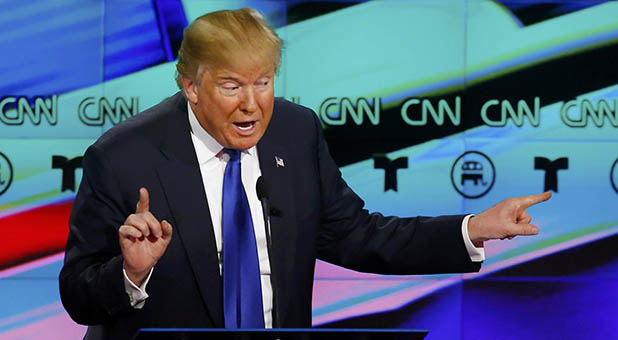Cutting Waste, Fraud and Abuse Isn’t Enough
Every election season, politicians are asked how they will fix our ever-growing budget crisis. And every season at least one politician gives the same trite answer: By cutting “fraud, waste and abuse.”
Politicians love the answer because it doesn’t offend any specific constituency. After all, there are no groups lobbying for more fraud, waste and abuse (at least not directly). And voters love the answer because it fits with both the conservative perception that government is mostly wasteful and should be fixed and the liberal perception that government is mostly efficient and can be made even more so.
Neither the politicians nor the voters are completely wrong. Fraud, waste and abuse are indeed a perennial problem, which is why the government has thousands of auditors, evaluators and inspectors constantly trying to root it out. But would eliminating all fraud, waste and abuse truly save the taxpayers that much money?
Donald Trump seems to think so. In the latest Republican presidential debate, he claimed that he could fix the current budget deficit simply by cutting out the “waste, fraud and abuse”:
BLITZER: Mr. Trump—Mr. Trump. If you eliminate completely the Department of Education, as you have proposed, that’s about $68 billion. If you eliminate the Environmental Protection Agency, that’s about $8 billion. That’s about $76 billion for those two agencies.
The current deficit this year is $544 billion. Where are you going to come up with the money?
TRUMP: Waste, fraud and abuse all over the place. Waste, fraud and abuse.
You look at what’s happening with Social Security, you look—look at what’s happening with every agency—waste, fraud and abuse. We will cut so much, your head will spin.
Let’s take Mr. Trump at his word and consider how much we’d need to cut to “make our head spin.”
As moderator Wolf Blitzer pointed out, the current deficit is $544 billion. The deficit is the amount of money the government spends each year that exceeds the revenues brought in from taxes. Bringing the deficit to zero would balance the budget and prevent us from adding—at least for a year—to the national debt.
The federal budget itself is comprised of two types of spending: discretionary and mandatory. Discretionary spending is the portion of the budget that the president requests and Congress appropriates every year. It represents less than one-third of the total federal budget, while mandatory spending accounts for around two-thirds.
Trump mentions Social Security, a (mostly) nondiscretionary spending program that he would have no control over as president. The only area that he could potentially influence is discretionary spending, so we’ll focus solely on that part of the budget.
How can we evaluate Trump’s claim? By using the following three steps:
Ask “How big is that number?”—To get a better feel for the size of $544 billion, translate it to something that helps put it into perspective. For example, I’ve lived in both Virginia and Washington State, so I have a rough feel for how many people live in those states.
If you had $544 billion, you could buy 18,133,333 cars at $30,000 each. That’s the equivalent of buying every man, woman and child in Virginia and Washington State a brand-new Ford Mustang—and having enough money left over to buy everyone in New Mexico one too!
Convert the numbers to a common unit—When talking about the budget, politicians frequently talk about billions and trillions as if they were on the same scale. This can lead to considerable confusion, particularly when we’re trying to determine where to save money. To make it easier to understand, let’s convert trillions to billions: 1 trillion = 1,000 billion.
The discretionary portion of the federal budget is $1.1 trillion so that equates to $1,100 billion. This means the $544 billion deficit is almost exactly half as much as the total for all discretionary spending.
Ask, “Is the claim plausible?”—Now that we know how much we need to cut from the discretionary spending portion of the budget—about half—we can better assess the claim.
Let’s start by assuming that all the “waste, fraud and abuse” is in the Department of Defense. The deficit is almost as large as the total discretionary spending, $598 billion (about 53 percent of total discretionary spending), that is spent solely on the military. If we made all the cuts from the military ($598–544 billion) we’d only have enough money left over to buy one aircraft carrier ($42 billion) and (almost) enough to pay military salaries for one month (about $12 billion).
That’s not really feasible.
What if instead we simply cut out entire nonmilitary government programs? To save $544 billion, we’d need to cut all non-military mandatory spending—all of it. Everything spent on food and agriculture, transportation, unemployment, science, energy, environment, international affairs, housing, health, education, veteran’s benefits and all costs associated with running the government.
And that would still not be enough. We’d still need to take $37 billion from the military.
Is it plausible that there is really so much “waste, fraud and abuse” that it equals all the money spent on almost every single government program? No, it’s not. But politicians, like Trump, think the average American citizen is dumb enough to believe that all that is needed is to “trim the fat” and we can solve the deficit problem.
We Americans may be innumerate, but we’re not dumb. With a bit of “guesstimation” work we can clearly see that such magical thinking about the budget is nonsense.
Joe Carter is a senior editor at the Acton Institute. Joe also serves as an editor at the The Gospel Coalition, a communications specialist for the Ethics and Religious Liberty Commission of the Southern Baptist Convention, and as an adjunct professor of journalism at Patrick Henry College.
















































